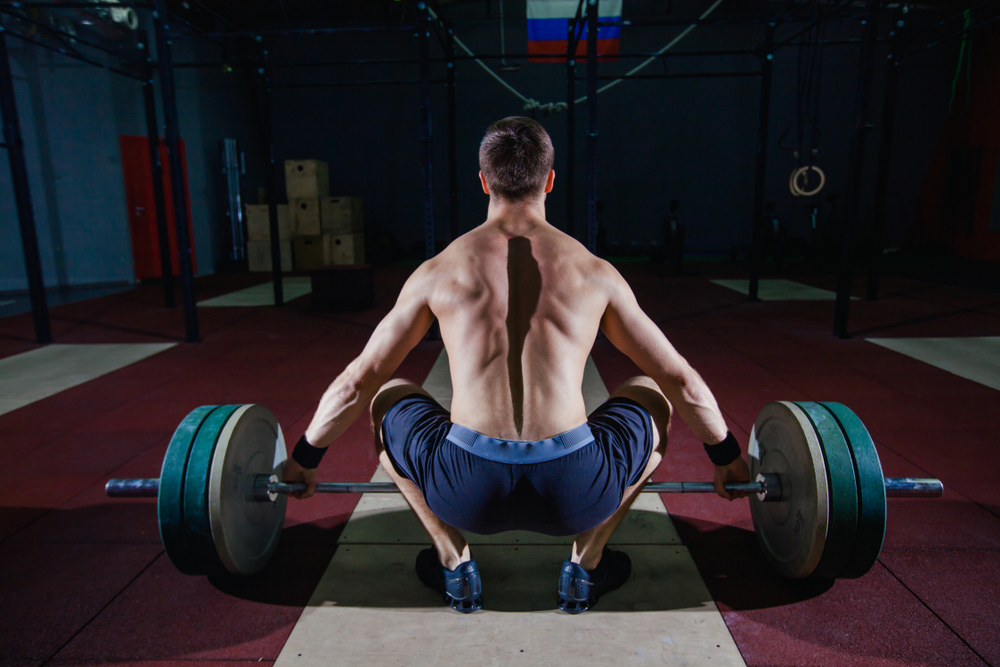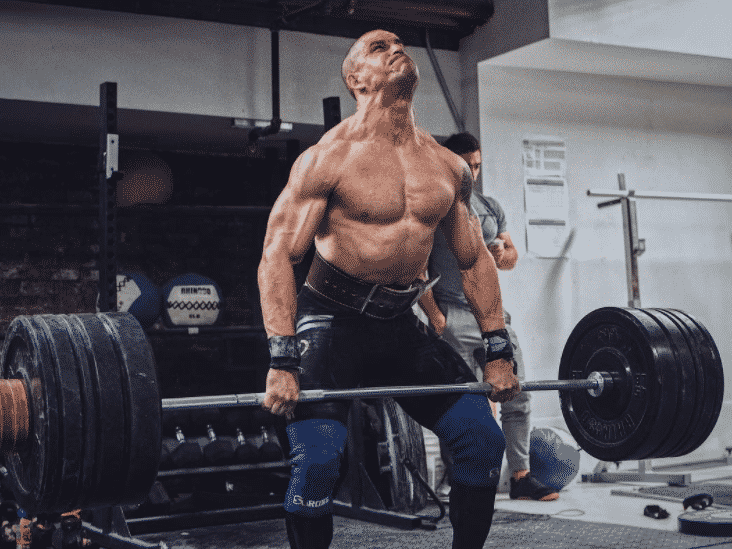The Olympic lifts are highly technical movements that require countless hours of technique training and analysis. Like most skills, the more you do them, the better you will become; assuming you are practicing them properly.
Many beginners and intermediate lifters are unsure as to what frequency they should train the Olympic lifts (snatch, clean, and jerk). To better answer this question, we need to dive deeper…
In this article, we will discuss:
- What is the Optimal Training Frequency for the Olympic Lifts?
- Factors That Influence Optimal Training Frequency
- How to Determine What Training Frequency Works Best for You
- Sample Olympic Weightlifting Programs (3, 4, and 5-Day Programs)
Disclaimer – Performing Olympic Lifts in WODs
It is important to note that performing Olympic Lifting movements in workouts under fatigue, time constraints, and loads less than 70% of maximum often do not effectively translate to Olympic weightlifting performance.
If you are looking to improve your snatch and clean and jerk technique prowess and/or maximums, you need to devote time specifically to train the Olympic lifts in a more focused, less fatigued state. Additionally, this may also include dedicated strength work depending on your individual weaknesses.
Lastly, do understand that performing high amounts of repetitions with the Olympic lifts often results in fatigue and poor technique and behaviors, further damaging your ability to be explosives, precise, and competent in the Olympic lifts at near-maximal and maximal loads.
To conclude, if you are looking to improve the Olympic lifts and are not taking the time to seek out a qualified coach who has high experience with coaching the Olympic lifts or has achieved some level of success as an athlete, your first step should be seeking help. From there, you need to allocate training days and/or time to fix bad habits and develop better ones.
What is the Best Training Frequency for the Olympic Lifts?
It depends…
Like most things in life, the answer is not straightforward, as it is dependent on a variety of factors; each influencing the next.
In short, the more you can train the Olympic lifts, then the more exposure you have to them. In doing so, you can address technical faults, create better movement patterning, and enhance skill and movement specificity daily. Some factors will limit your ability to train daily and are discussed below.
For most individuals, start with the below guidelines to establish better Olympic lifting technique and performance.
- Beginners: 3 days per week, with sessions consisting of 4-5 movements in total. Movements will often integrate a snatch and clean and jerk variation, as well as some sort of squatting or pulling work. Lastly, accessory movements can be used like push presses and/or snatch balances to address poor positional awareness and timing. Sessions often last 45-60 minutes in total.
- Intermediate Lifters: 3-5 days per week, and can vary depending on the individual lifter’s timelines, ability to recovery, and schedule. Many lifters have had success training 3 times per week for slightly longer sessions, while others have found success training more frequently for shorter durations per training session.
- Advanced Athletes: Advanced lifters and competitive athletes can often train 5 or 6 days per week. The key here is to monitor recovery, training volume, and have a program that varies training loading and emphasis per day (light, medium, and heavy days). Most sessions are 60-75 minutes long, and allow for an athlete to train the movements most days of the week.
- Recreational Fitness-Goers: Fitness enthusiasts and CrossFitters looking to improve general Olympic lifting technique yet might not be fully ready to engulf themselves in formal Olympic weightlifting training can still find success training the movements 2-3 day per week for 30 minutes per session. This is often common in CrossFit-style workouts as lifters can still devote some time to the snatch and clean and jerk variations, yet then train other aspects of their fitness afterwards. As discussed above, this can be tricky if someone has specific issues in the snatch or clean and jerk that are not being addressed and/or if they are performing the Olympic lifts without a high degree of technical awareness and coaching.
What Factors Will Influence Optimal Training Frequency of the Olympic Lifts?
Below are some of the most influential factors impacting optimal training frequency of the Olympic lifts. It is important to note that “optimal” is a relative term in this case, as some lifters may find less frequency and longer sessions work best while others find that more frequency but shorter sessions produce results for them.
Work through the below factors to better understand which is the optimal training frequency for you to choose.
Your Expectations
The higher expectations you have, the more time you will need to sacrifice in order to allow for more Olympic lifting specific training and recovery. There is no magic answer as to what the most optimal training frequency is per week, however at a bare minimum you should be training the snatch 3 times per week and the clean and jerk 2-3 times per week.
Your Current Progress (or Lack Thereof)
If it ain’t broke, don’t fix it! The truth of the matter is, there isn’t a magic frequency to train the Olympic lifts, only a range that is highly dependent on your lifestyle, goals, timelines, and current state.
If you are someone who has been struggling with the Olympic lifts and can’t seem to understand why you are not improving, one of three things needs to happen:
- You need to train the lifts more frequently, even if that means adding 1-2 movements into you training program 2-3 day per week.
- You are training them currently, but are doing so in a way that is not conducive to your success.
- You are not capable of learning the lifts on your own, and therefore should seek out a coach.
If you are someone who has seen progressive improvements in your Olympic lifts and are happy with your progress, then odds are you doing the right things. Once you find that the progress starts to slow down, evaluate your current training program and re-read this article.
Ability to Recover
While many factors can impact recovery it is important to monitor your ability to recovery and train on a day to day basis. If you are training too aggressively (often in the from of using too much volume or too high of intensities per session, rather than too much frequency), you will end up injured and plateaued.
As a general rule of thumb, the more frequent you train, the less volume you do per session as the total weekly volume is spread out across the week. If you only train 2-3 days per week, your volume is generally higher per session and therefore your recovery needs are greater in between sessions in comparison to training 4-5 training session per week.
Age (Training and Chronological)
Generally speaking, beginner lifters cannot handle the high amounts of stress and intensities that more advanced lifters can. Many beginners and intermediate lifters who become injured often throw themselves into more advanced training templates rather than working with a coach who understands the needs of a less experienced lifter.
Furthermore, older athletes tend to have a slower abilities to recover due to physiological processes as well as other stressors placed upon them (kids, work schedules, etc). This is not always the case, but a skilled coach should understand the differences and monitor life, work, and family stress with beginner and older athletes to best individualize programming.
Stress Levels
Stress can some in all shapes and sizes, and often has the most impact on us outside of the gym. Work stress, family, relationships, and lack of sleep are just a few stressors that can wreak havoc on your recovery and ability to train more frequently. If you are not managing your stress in other aspects of your life, your training frequency and volume per session must also be manipulated.

Nutrition
As with all things, nutrition plays a large role in your ability to recover from training. If you are not eating enough calories or are falling short of carbohydrates and protein within your diet your training and recovery will suffer.
Doing Other Forms of Fitness
While there is no rule against you diversifying your fitness, be sure to understand the balance between training Olympic weightlifting and other fitness modalities like running, powerlifting, strongman, and CrossFit. If you are not strictly following an Olympic lifting program that accounts for all the weekly training volumes and stress, you need to be careful that your other fitness activities do not impede recovery and training progress.
How to Determine What Training Frequency is Best for You?
At this point, we have covered nearly everything you need to know about the factors that influence your training, recovery, and progress. That said, here are three questions you need to answer truthfully in order to establish YOUR optimal frequency for training the Olympic lifts!
What Are Your Expectations and Timelines?
If you have aggressive goals and are looking to maximize the next 6-12 weeks of training, you need to understand that you cannot make the progress you need doing one workout per week. Simply put, the more aggressive your goals the more time, energy, and training you need to allocate towards Olympic weightlifting specific training.

What Are You Able to Give Up?
If you are a recreational lifter and are looking for basic results and improvements, then you most likely can get away training the lifts 2-3 times per week for 30 minutes each session.
If, however, you are more advanced and/or are looking to vastly improve in the lifts, you need to understand that the bulk of your training should come from formal Olympic lifting training. Shifting 20-50% more of your training time towards weightlifting could yield great results, however this means you also need to then spend less time on other aspects of fitness as well.
What Can You Commit To?
Most of us cannot train 4 hours per day, 6 days per week. If that was the case, we could all pull off two-a-days, sleep and take naps in-between sessions, and go through life without stress.
That said, you need to look at your family, life, and work schedule and find a frequency that you can commit to. This may mean 3 days per week for 60 minute Olympic weightlifting focused sessions. It may mean taking 30 minutes every workout to practice the lifts. Whatever you can do, commit to it and make a plan.
Sample Olympic Lifting Workout Plans
Below are three sample workout plans for lifters looking to train 3, 4, or 5-days per week. Note, that these are just one week’s worth of training and do not include progressions or demonstrate how to systematically integrate periodization within training to elicit positive adaptations.
Below are three sample training programs that vary in training frequency and the overall training volume per week is similar. Additionally, the below programs represent training done in a base phase in which accumulating volume and improving technique is the emphasis. These programs would then move towards more strength and competition phases.
3-Day Olympic Lifting Program
Day 1
- Snatch Pull + Hang Snatch: 4(1+1)/70-80%
- Power Clean + Power Jerk: 4(2)/70-80%
- Snatch Balance: 4(3)/70-75% of snatch
- Front Squat: 4(3)/70-75%
Day 2
- No Foot Snatch: 4(3)/70%
- Block Clean: 4(3)/70%
- Behind the Neck Jerk: 4(3)/70%
- Snatch Pulls: 4(4)/90-100% of snatch max
Day 3
- Snatch + Hang Snatch: 4(1+1)/70-75%
- Hang Power Clean + Jerk: 4(2+2)/70-75%
- Back Squat: 4(5)/70-75%
- Clean RDL: 4(5)/90-100% of clean max
4-Day Olympic Lifting Program
Day 1
- High Block Snatch: 3(3)/70-80%
- Low Block Power Clean: 3(3)/70-80%
- Back Squat 3(5)/70-75%
- Goodmorning: 3(8)
Day 2
- Power Snatch: 4(2)/70%
- Power Clean + Push Press: 4(1+3)/70-75% of push press max
- Snatch Balance: 4(3)/70-75% of snatch max
- Snatch Pulls: 4(4)/90-100% of snatch max
Day 3
- Hang Snatch + Snatch: 3(1+2)/70-75%
- Power Clean + Front Squat + Jerk: 4(1+1+1)/70-75%
- Power Jerk: 4(3)/70-75%
- Weight Pull Up: 4(6-8)
Day 4
- Snatch + Overhead Squat: 3(1+1)/80-85%
- Block Clean + Jerk: 3(1)/80-85%
- Front Squat: 3(3)/75-80%
- Clean Pull: 3(3)/90-100% of clean max
5-Day Olympic Lifting Program
Day 1
- Muscle Snatch 3(3)
- Power Snatch + Overhead Squat: 4(2+1)/70-80%
- Floating Snatch Pull from Riser 3(5)/100-110% of snatch max
- Back Squat 4(8)/RPE 7
Day 2
- Snatch: 4(3)/70-75%
- Hang Power Clean:4(2)/70%
- Jerk from Blocks: 4(3)/70-80%
- Dips 3(10)
- Chin Up 3(8-10)
Day 3
- Snatch Push Press + Snatch Balance 4(2+2)/70-80% of snatch max
- Snatch High Pull 4(3)/75-80% of snatch max
- Front Squat: 4(3)/70-75%
- Box Jump: 4(3)
Day 4
- Power Snatch 4(2)/70-75%
- Hang Power Clean: 4(2)/70-75%
- Jerk from Rack 4(3)/70-80%
- Pendlay Row 4(5)
Day 5
- Snatch + Overhead Squat 4(1)/80-85%
- Clean 4(1)/80-85%
- Front Squat: 4(3)/75%
- Clean RDL 4(5)/90-100% of clean max
Olympic Weightlifting Articles
Looking to go all in on improving your Olympic lifts? Take a look at the elbow Olympic lifting guides and learn to address your weaknesses and improve performance!
- 3 Keys to the Perfect Weightlifting Program
- 10 Things Every Beginner and Intermediate Weightlifter Should Learn
Feature image from A.RICARDO/Shutterstock.
Editor’s note: This article is an op-ed. The views expressed herein and in the video are the author’s and don’t necessarily reflect the views of BarBend. Claims, assertions, opinions, and quotes have been sourced exclusively by the author.




